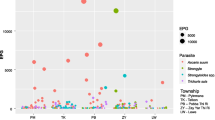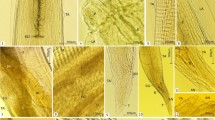Abstract
Purpose
Tapeworms of Avitellina spp. are among those gastrointestinal parasitic helminths which infect wild and domestic ruminants worldwide leading to various clinical manifestations in the ruminant hosts, thereby causing considerable economic losses in livestock production. While these worms are among the major constraints in ruminant livestock raising, there is very meagre molecular information available making their identity error-prone. This study aimed to provide insights into the genetic characterization of these economically important tapeworms.
Methods
In the present study, we examined 480 guts of slaughtered goats (n = 413) and sheep (n = 67) of which 74 guts were found infected with anoplocephalid cestodes (sheep gut:18; goat gut:56). A total of 27 Avitellina lahorea worms (19 from goat and 8 from sheep) were isolated, fixed, relaxed and stained using Gower’s carmine stain. For molecular analyses, the genomic DNA was extracted and fragments of cytochrome c oxidase subunit 1 (cox1) gene, internal transcribed spacer1-5.8S ribosomal RNA (ITS1-5.8S rRNA) gene, and small subunit ribosomal RNA (18S rRNA) gene were amplified and sequenced.
Results
Based on snail-shaped paruterine organs and other morphological and morphometric features, the worms were identified as Avitellina lahorea. The phylogenetic analyses, based on our original cox1 gene sequence and those available from NCBI GenBank, showed Avitellina tapeworms as a sister lineage of Thysaniezia with 14 to 17% genetic divergence. Molecular analyses of 18S rRNA gene sequences depicted the present isolate as one of the species of the genus Avitellina clustering with A. centripunctata as a separate species in the phylogenetic tree with 92% homogeneity in sequences. In conjunction with existing data of internal transcribed spacer1-5.8S rRNA (ITS1-5.8S rRNA) gene, the phylogenetic analysis placed the present isolate among the anoplocephalids as one of the species.
Conclusion
The present study is the first molecular report on A. lahorea isolated from sheep and goats with the simultaneous use of a morphological approach, and certainly contributes to bridging the existing gaps in the understanding of these economically important parasites.





Similar content being viewed by others
Availability of Data and Material
The dataset generated during the present study is available from the corresponding author upon reasonable request.
References
Bedada H, Giza F, Negash W (2017) Preliminary study on small ruminant GIT helminthiasis in select arid and semi-arid pastoral and agro-pastoral areas of Afar region, Ethiopia. Int J Adv Res Biol Sci 4:60–67
Sato MO, Sato M, Chaisiri K et al (2014) Nematode infection among ruminants in monsoon climate (Ban-Lahanam, Lao PDR) and its role as food-borne zoonosis. Rev Bras Parasitol Veterinária 23:80–84
Rajapakse RPVJ, Faizal ACM, Horadagoda NU et al (2010) An abattoir study on the prevalence of gastrointestinal nematodes of goats in the dry zone of Sri Lanka. J Natl Sci Found Sri Lanka 28(4):265–275
Euzeby J (1966) Les maladies vermineuses des animaux domestiques et leurs incidences sur la pathologie humaine vol 2-maladies dues aux plathelminthes issue 1. Vigot Freres Editeurs, pp 1–36
Gaware A, Borde S, Thosar A (2017) Rediscription of a species from Capra hircus, Avitellina centripunctata Rivolto, (1874) from Jalna distinct (M.S.), India. Indian J Appl Res 7:551–553
Denegri G, Bernadina W, Perez-Serrano J, Rodriguez-Caabeiro F (1998) Anoplocephalid cestodes of veterinary and medical significance: A review. Folia Parasitol (Praha) 45:1–8
Soulsby EJL (1982) Helminthes, arthropods and protozoa of domesticate animals. Baillier tindall, London
Ndom M, Diop G, Quilichini Y et al (2016) Prevalence and scanning electron microscopic identification of anoplocephalid cestodes among small ruminants in Senegal. J Parasitol Res. https://doi.org/10.1155/2016/3937292
Gough LH (1911) Memoirs: a monograph of the tape-worms of the subfamily Avitellininæ, being a revision of the genus Stilesia, and an account of the histology of Avitellina centripunctata (Riv.). J Cell Sci 2:317–385
Rivolta S (1874) Sopra alcune specie di tenie delle pecore e sopra speciali cellule oviformi dei villi del cane e del gatto. Pisa(Cited by Wenyon, 32)
Kalse AT, Suryawanshi RB, Patil SA (2017) Avitellina sarkriensis n. sp (Eucestoda: Thysanosomidol) from Capra hircus. Proc Zool Soc lndia 16:67–70
Ba CT, Wang XQ, Renaud F et al (1994) Diversity in the genera Avitellina and Thysaniezia (Cestoda: Cyclophyllidea): genetic evidence. J Helminthol Soc Wash 61:57–60
Ndom M, Diop G, Yanagida T et al (2019) Morphological and genetic characterizations of Avitellina tapeworms from domestic ruminants in Senegal: an evidence of specificity among sheep and cattle host. Vet Parasitol Reg Stud Rep 18:100337
Woodland WNF (1927) On three new species of Avitellina (cestoda) from India and the anglo-Egyptian sudan, with a re-description of the type-species A. Centripunctata (rivolta), 1874. Ann Trop Med Parasitol 21:385–414. https://doi.org/10.1080/00034983.1927.11684546
Bhalerao GD (1936) On some representatives of the cestode genus Avitellina from India. J Helminthol 14:141–162
Diop G, Yanagida T, Hailemariam Z et al (2015) Genetic characterization of Moniezia species in Senegal and Ethiopia. Parasitol Int 64:256–260. https://doi.org/10.1016/j.parint.2015.02.008
Guo A (2017) Moniezia benedeni and Moniezia expansa are distinct cestode species based on complete mitochondrial genomes. Acta Trop 166:287–292. https://doi.org/10.1016/j.actatropica.2016.11.032
Ndom M, Yanagida T, Diop G et al (2018) Genetic and morphological characterization of Thysaniezia tapeworms from cattle and sheep in Senegal. Vet Parasitol Reg Stud Rep 11:27–31
Gower WC (1939) A modified stain and procedure for trematodes. Stain Technol 14:31–32
Untergasser A, Cutcutache I, Koressaar T et al (2012) Primer3—new capabilities and interfaces. Nucleic Acids Res 40:e115–e115
Nguyen TD, Le QD, Huynh VV et al (2012) The development of PCR methodology for the identification of species of the tapeworm Moniezia from cattle, goats and sheep in central Vietnam. J Helminthol 86:426–429. https://doi.org/10.1017/S0022149X11000629
Sanger F, Nicklen S, Coulson AR (1977) DNA sequencing with chain-terminating inhibitors. Proc Natl Acad Sci 74:5463–5467
Tamura K, Stecher G, Kumar S (2021) MEGA11: molecular evolutionary genetics analysis version 11. Mol Biol Evol 38:3022–3027. https://doi.org/10.1093/molbev/msab120
Kimura M (1980) A simple method for estimating evolutionary rates of base substitutions through comparative studies of nucleotide sequences. J Mol Evol 16:111–120. https://doi.org/10.1007/BF01731581
Spasski AA (1961) Essentials of cestodology. In: Skryabin KI (eds) vol. I. Anoplocephalate tapeworms of domestic and wild animals. Jerusalem: Israel Program for Scientific Translations (for the National Science Foundation and the Department of Agriculture, Washington, D.C.)
Spasskii AA (1951) Anoplocephalate tapeworms of domestic and wild animals (English translation). Acad Sci USSR, Moscow
Khalil LF, Jones A, Bray RA (1994) Keys to the cestode parasites of vertebrates. CAB International, Wallingford
Yamaguti S (1959) Systema Helminthum. Vol. H. The cestodes of vertebrates. New York 1: Interscience Publishers, Inc., 250, Fifth Avenue, New York
Nickol BB, Khalil LF, Jones A, Bray RA (1995) Keys to the cestode parasites of vertebrates. J Parasitol 81:929. https://doi.org/10.2307/3284043
Acknowledgements
Authors are thankful to the Department of Zoology, Panjab University, Chandigarh, India where the research work has been performed.
Funding
The present study was supported by financial assistance from the University Grants Commission (UGC), Govt. of India as a fellowship (JRF and SRF) under grant no. F.16–6(DEC.2016)/2017(NET). Recipient: Susheel Kumar.
Author information
Authors and Affiliations
Contributions
Research work, writing the research paper—original draft preparation by Susheel Kumar. The research work was supervised, draft reviewed, and edited by Harpreet Kaur.
Corresponding author
Ethics declarations
Conflict of interest
The authors declare that they have no known competing financial interests or personal relationships that could have appeared to influence the work reported in this paper.
Ethics Approval
Ethical clearance was obtained from the Institutional Animal Ethics Committee (IAEC) of Panjab University (Approval No.: PU/45/ 99/CPCSEA/IAEC/481).
Consent to Participate
Not applicable.
Consent for Publication
All authors agree to publish this manuscript.
Additional information
Publisher's Note
Springer Nature remains neutral with regard to jurisdictional claims in published maps and institutional affiliations.
Rights and permissions
Springer Nature or its licensor (e.g. a society or other partner) holds exclusive rights to this article under a publishing agreement with the author(s) or other rightsholder(s); author self-archiving of the accepted manuscript version of this article is solely governed by the terms of such publishing agreement and applicable law.
About this article
Cite this article
Kumar, S., Kaur, H. Molecular Characterization of Avitellina lahorea Woodland, 1927 (Class Cestoda; Family Anoplocephalidae) Infecting Sheep and Goats Raised in India. Acta Parasit. 68, 359–371 (2023). https://doi.org/10.1007/s11686-023-00671-4
Received:
Accepted:
Published:
Issue Date:
DOI: https://doi.org/10.1007/s11686-023-00671-4




